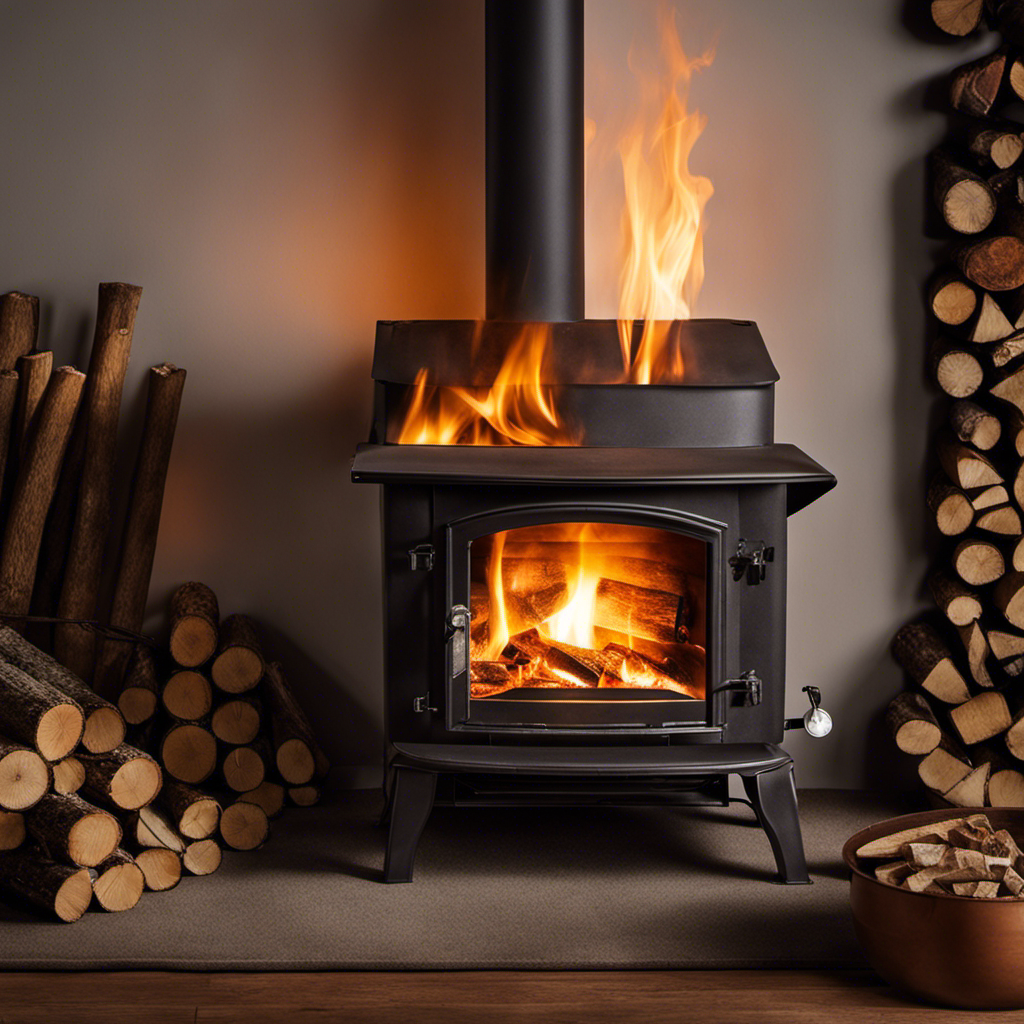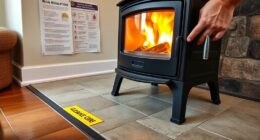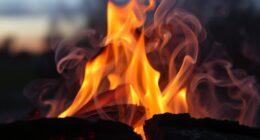Sitting by the crackling fire in my wood stove, feeling the cozy heat fill the room, emphasizes the significance of understanding how to properly put out a fire.
In this concise guide, I will walk you through the necessary steps to safely and effectively put out a wood stove.
From assessing the fire to controlling the airflow, we will cover every aspect of ensuring a complete extinguishment.
Let’s dive in and learn how to handle this task with confidence and authority.
Key Takeaways
- Ensure everyone’s safety by checking for signs of smoke or flames beyond the wood stove.
- Gather necessary tools such as a fire extinguisher, heat-resistant gloves, and a metal shovel.
- Control the airflow and reduce oxygen supply to manage the fire and prevent flare-ups.
- Safely remove burning wood and clear the stove using appropriate tools and disposal methods.
Assessing the Fire: Understanding the Situation
I need to quickly assess the fire to understand the situation and determine the best course of action.
When it comes to evaluating safety, the first thing I do is ensure that everyone is out of harm’s way. I check for any signs of smoke or flames that may have spread beyond the wood stove.
Next, I focus on monitoring the temperature. I use a digital thermometer to measure the heat inside the stove and around its surroundings. This helps me gauge the intensity of the fire and determine if it’s within a safe range.
Additionally, I keep an eye out for any unusual odors or sounds that may indicate a potential problem.
Gathering the Necessary Tools: Be Prepared
I gather all the necessary tools, such as a fire extinguisher and heat-resistant gloves, to be prepared for any potential emergencies. Fire safety is essential when it comes to stove maintenance. Here are three important tools to have on hand:
-
Fire extinguisher: This is a crucial tool for quickly extinguishing any flames that may occur. Make sure to choose an extinguisher suitable for use on wood fires.
-
Heat-resistant gloves: These gloves will protect your hands from burns while handling hot materials or logs. They allow you to safely adjust the fire or remove any burning debris.
-
Metal shovel: A metal shovel is useful for safely removing hot ashes or coals from the stove. It helps prevent accidental fires by properly disposing of hot materials.
By having these tools readily available, you can effectively respond to any fire-related emergencies that may arise while maintaining your wood stove.
Now, let’s move on to controlling the airflow and reducing the oxygen supply.
Controlling the Airflow: Reducing Oxygen Supply
To effectively control the airflow and reduce the oxygen supply, I need to adjust the damper and close the air vents.
Managing smoke and preventing flare-ups are crucial aspects of maintaining a safe and efficient wood stove. By adjusting the damper, I can regulate the amount of air entering the stove and control the intensity of the fire. Closing the air vents restricts the oxygen supply, which helps manage the smoke production and reduces the risk of flare-ups.
It’s important to find the right balance between airflow and combustion to ensure optimal performance. Too much air can cause the fire to burn too hot and create excessive smoke, while too little air can lead to incomplete combustion and the production of harmful gases.
Removing Burning Wood: Safely Clearing the Stove
Carefully removing the burning wood from the stove is essential to ensure safety and prevent any potential accidents. When it comes to clearing ashes and disposing of them properly, here are three important steps to follow:
-
Allow the fire to completely burn out: Before attempting to remove any burning wood or ashes from the stove, it’s crucial to ensure that the fire has completely extinguished. This will minimize the risk of accidental burns or spreading of embers.
-
Use appropriate tools: To safely handle the burning wood and ashes, it’s recommended to use fireplace gloves, tongs, or a shovel specifically designed for this purpose. These tools will protect your hands and allow for better control during the removal process.
-
Proper disposal: Once you have removed the burning wood and ashes from the stove, it’s important to dispose of them properly. Never dispose of hot ashes in plastic bags or containers, as they can pose a fire hazard. Instead, transfer them to a metal bucket or container and let them cool down completely before disposing of them in a designated ash bin or outdoor area away from any flammable materials.
Ensuring Complete Extinguishment: Double-checking for Safety
When double-checking for safety, it’s important to ensure the complete extinguishment of the fire in order to prevent any potential accidents.
After extinguishing a fire, it’s crucial to check for any remaining embers or hot spots that could potentially reignite the fire. To prevent re-ignition, carefully inspect the entire area, including the wood stove and the surrounding area, for any signs of heat or glowing embers.
Use a heat-resistant glove or tool to gently touch the ash and debris, making sure it’s cool to the touch.
Additionally, check the chimney and flue to ensure they’re clear of any obstructions or build-up.
Frequently Asked Questions
Can I Use Water to Extinguish a Wood Stove Fire?
Yes, you can use water to extinguish a wood stove fire, but it’s not recommended. Using sand or baking soda is safer as water can cause steam and spread the fire. Alternatively, a fire blanket can be used to smother the flames.
What Should I Do if the Fire in My Wood Stove Is Spreading to Nearby Objects?
If the fire in my wood stove is spreading to nearby objects, I should remember these fire safety tips. First, call 911. Then, evacuate everyone safely. Finally, use a fire extinguisher if possible.
How Often Should I Clean My Wood Stove to Prevent Fires?
To prevent creosote buildup and reduce the risk of chimney fires, it is recommended to clean your wood stove at least once a year. Signs of a chimney fire include loud cracking noises and dense smoke.
Can I Leave the Wood Stove Unattended While It Is Still Burning?
Leaving a wood stove unattended while it’s still burning is like playing with fire. It’s crucial to prioritize safety precautions and never leave it alone. Always ensure the fire is completely extinguished before leaving.
Is It Safe to Use a Fire Extinguisher to Put Out a Wood Stove Fire?
Using a fire extinguisher is generally safe for putting out a wood stove fire. However, it’s important to follow best practices for wood stove safety and consider alternative methods like using sand or baking soda.
Conclusion
In conclusion, properly extinguishing a wood stove is crucial for safety and preventing potential hazards. By assessing the fire, gathering the necessary tools, controlling the airflow, removing burning wood, and ensuring complete extinguishment, you can effectively put out a wood stove.
For example, in a case study, a family in a remote cabin followed these steps to safely extinguish their wood stove after enjoying a cozy evening by the fire, ensuring their home was protected from any potential fire risks.
Logan’s affair with adventure began in childhood. He hailed from a small town where vast forests bordered one side and endless shores stretched on the other. His days were spent exploring uncharted woods, climbing tall trees, or listening to the tales of old sailors. This early immersion in a world brimming with stories and mysteries became the foundation of his passion for writing.











